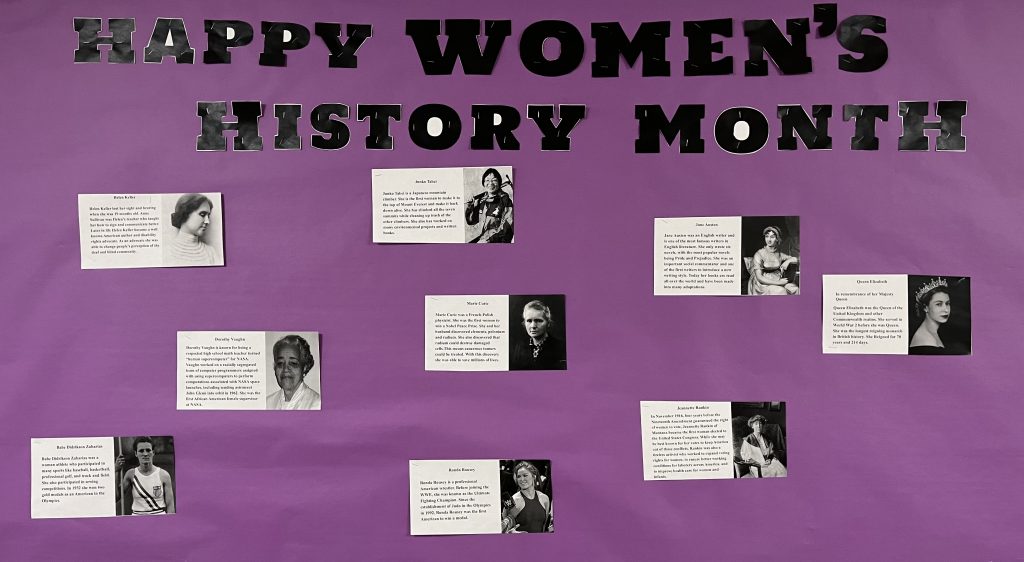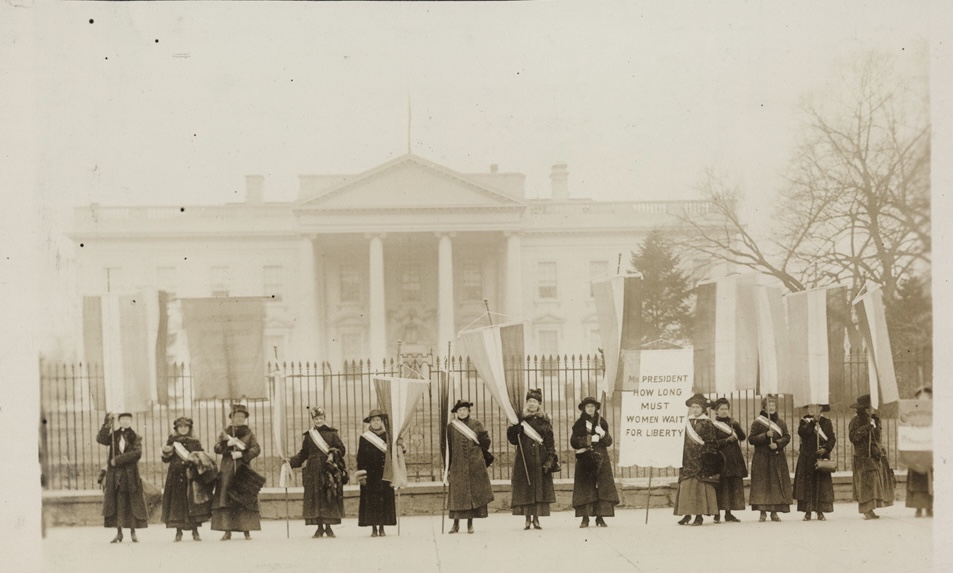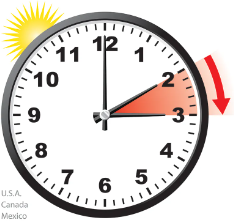
Women’s History Month begins on March 1 and ends on March 31.
Women’s History Month began in 1981-1982 as Women’s History Week, but became Women’s History Month in 1987 when Congressed passed Pub. L. 100-9. Since 1995, presidents have made yearly declarations of March being Women’s History Month.
“Women’s History Month is a dedicated month to reflect on the often overlooked contributions of women to United States history,” says History.com.
International Women’s Day takes place on March 8 with a long history dating back to 1908. Every year since the 1990’s there has been a different theme and the 2023 International Women’s Day theme is #EmbraceEquity. Visit IWD for more information.
The Fern Ridge Public Library is observing this month with a book display. Some of the books included are “Dead Feminists,” “The Book of Gutsy Women,” “Blood Water Paint,” and “Dumpln’.”
The school library will also have a display to commemorate this month. There is a bulletin board display for Women’s History Month in the hallway by the library, as well.
If you would like to get more involved in the month’s activities, there are some online events through Women’s History Month you can attend.
Women have made amazing impacts on history and have gained many rights and positions all over the world, but there is still work that must be done! Women continue to face discrimination and violence across the U.S. and across the globe.
Women are more likely to have physical and/or sexual violence committed against them. Nine out of every 10 victims of rape are female, with that resulting in 17.7 million American women since 1998. One out of six American women have been the victims of an attempted or completed rape in her lifetime. One in 10 women have been raped by an intimate partner.
When countries are in conflict, women and girls are at a heightened risk. Sexual violence has been used as a weapon of war throughout history, and has now been more apparent in the Russian and Ukraine war.
Domestic violence is more likely to happen to women as well. It is defined as “violent or aggressive behavior within the home, typically involving the violent abuse of a spouse or partner.”
One in three women have experienced some form of physical violence by a partner, compared to a rate of one in four men. These can include a multitude of behaviors and may not always be considered “domestic violence.” One in seven women have been injured by a partner. One in four women have been victims of severe physical violence by a partner.
One in seven women have been stalked by a partner to the point of being fearful. 19.3 million American women have been stalked in their lifetime, with roughly 60% of the stalkings being committed by a partner. 78% of people kidnapped into situations of trafficking are also women.
72% of all murder-suicides involves intimate partners, with 94% of these murder-suicide victims being female.
These crimes against women cause severe physical and mental health issues. Some of the issues included are STI/HIV contraction, PTSD, depression, anxiety, suicidal behavior, a higher risk of addiction, and many more issues.
The adult literacy rate is 83%, with male literacy rates being 88% and female literacy rates being 79%. Women make up two thirds of the world’s 796 million illiterate people.
Women are also paid less than men. For every dollar a man makes, a woman makes 83 cents.
It is even worse for women of color. Black women make 64 cents and Hispanic women are paid 57 cents for every dollar a man makes.
If you are under threat of any harm or violence, there are resources for you. The following numbers are common helplines:
The National Domestic Violence Hotline is 800-799-7233
The National Sexual Assault Hotline is 1-800-656-4673
Here is the history of the fight for women’s rights in the U.S.:
1776– Abigail Adams, future first lady, pleaded for her husband to “remember the ladies.”
1848– The first woman’s rights convention organized by women- the Seneca Falls Convention. This is held in New York with 300 attendees. 68 women and 32 men sign the Declaration of Sentiments, which started decades of activism and led to the 19th Amendment.
1849– Elizabeth Blackwell is the first woman to graduate from medical school and become a doctor in the U.S.
1851– Sojourner Truth, formerly enslaved turned women’s rights activist and abolitionist, delivered the famous “Ain’t I a Woman?” speech.
1869– In December, Wyoming passed the U.S.’s first women suffrage law, giving women the right to vote and hold office. Wyoming was the first state to give women the right to vote. In May, Susan B. Anthony and Elizabeth Cady Stanton founded the National Woman Suffrage Association.

1916– Margaret Sanger opens the fist birth control clinic in the U.S. She had to close many times due to legal threats, but founded the American Birth Control League in 1921.
1919– Women were granted the right to vote in the United States.
1932– Amelia Earhart becomes the first woman, and second pilot, to fly solo nonstop across the Atlantic.
1955– Rosa Parks helped launch the civil rights movement.
1960– The FDA approves the first commercially produced birth control pill. Margaret Sanger first commissioned the birth control pill with funding from Katherine McCormick.
1963– President John F. Kennedy signed the Equal Pay Act, which prohibits sex-based wage discrimination.
1964– President Lyndon B. Johnson signed the Civil Rights Act.
1966– Betty Friedan, author of Feminine Mystique, helped found the National Organization for Women.
1972– Title IX of the Education Amendments was signed by President Richard Nixon. It says that no person should be excluded from education based on sex.
1973– The Roe vs. Wade decision was reached, allowing women the legal right to an abortion. In September, “The Battle of the Sexes” occurred where tennis player Billie Jean King beat Bobby Riggs.
1981– Sandra Day O’Connor is the first woman to serve in the U.S. Supreme Court.
1983– Sally Ride is the first American woman in space.
1984– Geraldine Ferraro is the first woman vice president nominee by a major party.
1993– Janet Reno is the first female attorney general in the U.S.
1994– President Bill Clinton signed the Violence Against Women Act, which funded programs that help victims of rape, stalking, domestic violence, sexual assault, and other gender-related violence.
1997– Madeleine Albright is the U.S.’s first female secretary of state.
2007– Nancy Pelosi becomes the first woman speaker of the house.
2013– The United States military removes a ban against women serving in combat positions.
2016– Hilary Clinton was the first woman to receive a presidential nomination from a major political party.
2021– Kamala Harris is the first woman and woman of color Vice President for the United States.



